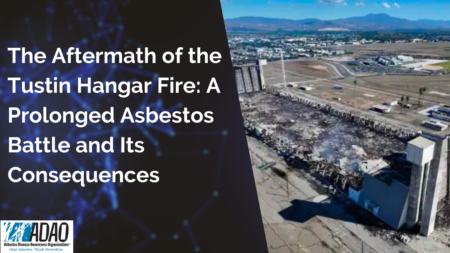Today, December 11, 2023, the Asbestos Disease Awareness Organization (ADAO), the International Association of Fire Fighters (IAFF), and the American Cancer Society Cancer Action Network (ACS CAN) sent a letter to The Honorable J. Luis Correa, Young Kim, Katie Porter, Michelle Steel, and Mike Levin, Members of Congress, regarding the recent catastrophic Tustin Hangar fire in California and its impact on public health. LETTER: https://lnkd.in/gxXhvSEt.
Posted on December 7, 2023

Photo Credit: Orange County Register
After an arduous 24-day battle, the massive fire at the Tustin military hangar in Orange County, California, was finally extinguished. This marked the culmination of a fierce fight against one of the county’s most significant fires in recent history. The Incident Management Team’s deployment of infrared drone flights to locate hidden hot spots beneath debris showcases the prowess of modern firefighting techniques. Yet, the end of the fire has not quelled the environmental and health concerns arising from the widespread asbestos debris.
The fire started on November 7th and consumed a historic World War II-era hangar at the former Tustin Air Base. This structure was an architectural gem and a symbol of Orange County’s rich military heritage. Its loss has deeply affected the community.
Environmental Concerns and Health Risks
Two days after the fire, the EPA detected asbestos and other hazardous chemicals in the debris. This discovery intensified concerns about potential health risks from the fire’s aftermath. Asbestos, a known carcinogen, underscores the peril in older constructions and highlights the necessity of emergency preparedness for such historic structures. Asbestos fibers are small and naked to the human eye, and can be inhaled during the fight to extinguish the fire or during the clean-up.
During the Tustin hangar fire, firefighters faced immense danger from the immediate threats of intense flames, structural collapse, and the prolonged exposure to toxic asbestos fibers released into the air. This exposure poses significant long-term health risks, including respiratory diseases and cancer, highlighting the need for enhanced protective measures and post-incident health monitoring for our brave first responders.
In a bipartisan move, Representatives Lou Correa (CA-46) and Young Kim (CA-40) urged the South Coast Air Quality Management District to conduct extensive air quality tests across Orange County. This action, motivated by worries about the spread of toxic debris, especially under the influence of the Santa Ana winds, emphasizes the importance of comprehensively understanding the fire’s environmental impact — as well as the impact of other wildfires and natural disasters.
The Navy’s allocation of $1 million to Tustin for cleanup efforts is a step towards recovery, but demolishing the hangar remains an intricate challenge. The cause of the fire is still under investigation, keeping the community in suspense for further updates.
Extended Risks to Firefighters and the Community
The Tustin Hangar Fire also highlighted a critical yet often overlooked issue – the heightened risk to firefighters and surrounding communities when asbestos-contaminated structures burn. When asbestos fibers are airborne due to fire, they pose severe health risks, including lung cancer and mesothelioma. Firefighters are often the first to encounter these hazards, putting them at a significantly increased risk, as are residents in the vicinity, due to potential exposure to asbestos-laden smoke and debris.
This scenario necessitates an urgent review and enhancement of safety protocols for firefighters and emergency response teams when it comes to asbestos and other toxins. They must be equipped with appropriate protective gear and trained in handling asbestos-related hazards in fire situations. Additionally, community awareness programs are crucial to educating residents about the risks and precautions to take during such incidents.
As Tustin and Orange County recuperate from the aftermath, this incident is a stark reminder of the challenges in managing and preserving historic structures, especially those with latent health hazards. For most of the 20th century, using asbestos and other toxic chemicals in construction was common. It is vital to be prepared for the repercussions of these historical choices, especially when disasters like fires occur.
A Call to Action
Communities, first responders, and local governments must be adequately educated and prepared to effectively respond while safeguarding public health from the dangerous toxins released during such events. As we reflect on the Tustin hangar fire, we must recognize the efforts of the firefighters, the Incident Management Team, the proactive measures by local representatives, and the community’s resilience.
Moving forward, it is imperative that lessons learned from this incident inform future policies and emergency response strategies to ensure public safety in the face of disaster. This event is a tragic reminder of the unmanageable risks posed by asbestos. Americans continue to face exposure threats and related diseases.
In light of this, we support the bipartisan momentum behind the Alan Reinstein Ban Asbestos Now (ARBAN) Act of 2023 and urge Congress to pass this life-saving legislation promptly.
Linda Reinstein
